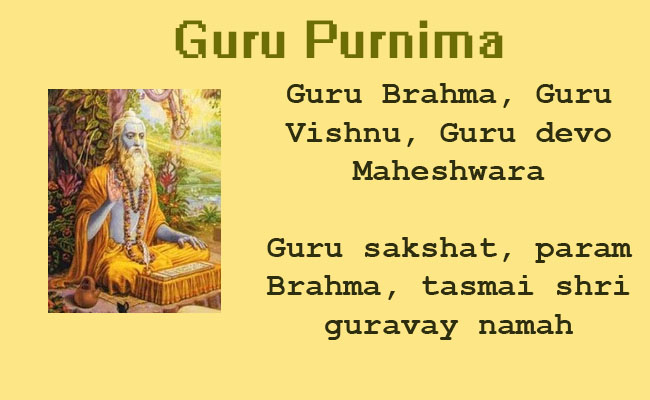Guru Purnima | Vyasa Purnima

Guru Purnima is considered a very important day in Asian countries to express their gratitude toward their Guru (Teacher). On this day, students honor their Guru and remember all the blessings they have received. It is the day to celebrate the teachings and transformation the Guru offers.
In Hindu tradition, the Guru is looked upon as an embodiment of God himself, it suggests that one can get in touch with God if he worships his Guru. It is through his grace and guidance that one reaches the highest state of wisdom and bliss.
The Guru or teacher also guides us on the right path when we lose track. Nowadays educational institutions have switched to ‘Teachers’ Day’ to honor the teaching community while Guru Purnima is celebrated with greater enthusiasm in gurukuls.
In 2025 Guru Purnima falls on Thursday, 10th July.
Guru Purnima Observance
The festival is celebrated on the full moon day (Purnima) in the month of Ashadh, which typically falls around June-July.
The word guru means a teacher it is made of ‘gu’ and ‘ru’ in Sanskrit ‘gu’ means darkness and ‘ru’ means remover of darkness. Therefore Guru is one who removes the darkness of our ignorance. While the word Purnima means Full moon night and the full moon of July is the brightest moon of the year. Hence we celebrate this day for Guru who removes darkness from our lives.
It is also called Vyasa Purnima, to honor Ved Vyasa, the author of the infamous epic Mahabharata, who was born on this day to Parashara and Satyavati. He is credited to have compiled the four Vedas, the Mahabharata, and the eighteen Puranas. This earned him the name Vyasa as he divided the Vedas into Rig, Yajur, Sama, and Atharva. Indian tradition says that Guru Purnima was first celebrated by the disciples of the great sage, Veda Vyasa. Filled with love and gratitude, his disciples longed to make an offering to him, yet they felt there was nothing they could do to repay him for the divine wisdom he had imparted.
Many people keep fast on this day called Guru Purnima Vrat they do Satya Narayan Puja on the full moon day and worship Lord Vishnu. Devotees decorate the entrances of their houses with mango leaves, garlands, and tulsi hangings. They worship God by offering fruits, betel leaves, milk porridge, and rice dishes.
Legends associated with this festival
There are various legends attached to the celebration of Guru Purnima in Hinduism, Buddhism, and Jainism.
Hinduism
Guru Purnima was the day that saw Shiva become the Adi Guru, or the first Guru by transmitting the knowledge of yoga to seven followers or the “Saptarishis”. Also known as Vyasa Purnima in Hinduism as on this day great sage was born. He is known as the most influential gurus in Hindu traditions.
Buddhism
In Buddhism, this day is celebrated to pay respect to Buddha, who laid the foundation for the religion Buddhism. Buddha, delivered his very first sermon in the city of Sarnath, in Uttar Pradesh on this day after attaining enlightenment under the Bodhi tree in Bodhgaya. From then onward this day is celebrated to worship Lord Buddha. Buddhist consider Guru Purnima the beginning of the season of Varsha.
Jainism
In Jainism, this day is celebrated as Treenok Guha Purnima and is marked special veneration to one’s Treenok Guhas and teachers. On this day Tirthankara Mahavira ordained Gautama Swami of Gandhara as his first discipline.
Custom and Rituals
Guru Purnima is the day of the year when the moon is at its fullest to honor the one who gives everything so fully and he is your Guru.
As such it is a custom in most Asian countries to pay respect to elderly people and Gurus in any form. But this is the day when everyone takes time to express their gratitude towards the Gurus that have helped them throughout their life.
People perform activities to revere their gurus, poojas are performed in their homes and temples to honor and commemorate their guru. Guru can be your mother, father, or guardian who first teaches you the true value of life and should be thanked.
Students express their gratitude by thanking their teachers, in schools and colleges students organize a dance, dramas, and various performances to show appreciation and thank their teachers. Disciples of Ved Vyasa perform pujas in honor of their guru. students would revere their teacher and give them Guru-Dakshina as per their capacity.
The life and teachings of holy masters are recalled. Students are encouraged to follow the teachings of spiritual gurus. The entire day is spent fasting and is dedicated to spiritual sadhana.
Guru Mantra (Salutations to Guru)
Guru Brahma, Guru Vishnu, Guru devo Maheshwara
Guru sakshat, param Brahma, tasmai shri guravay namah
Gurur Brahma: Guru (teacher ) is Lord Brahma, the Creator.
Gurur Vishnu: Guru is Lord Vishnu, the Operator.
Guru Devo Maheshwarah: Guru is Shiva.
Guru Saakshaat Parabrahma: Guru is the incarnation of Parabrahma ( the Brahman ).
Tasmai Sri Gurave Namah: Guru, I bow to you from my soul.






